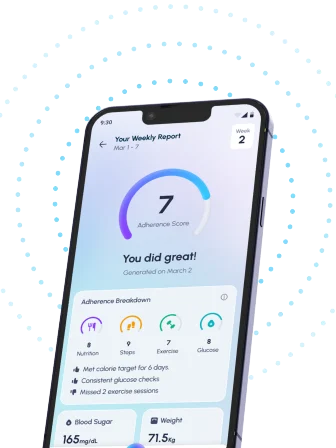Table of Contents
- Winter Diabetes: Cold Weather Challenges and Solutions
- Managing Blood Sugar During Winter’s Cold: Expert Tips
- Hypoglycemia in Winter: Prevention and Emergency Response Guide
- Beat the Winter Chill: Safeguarding Your Diabetes Health
- Cold Weather & Diabetes: A Comparison of Risks and Protective Measures
- Frequently Asked Questions
- References
Winter’s chill can bring more than just frosty mornings; it can also present unique challenges for people managing diabetes. Winter Diabetes Management: Avoiding Common Cold Weather Complications is crucial for maintaining good health during these colder months. We’ll explore how cold temperatures and seasonal changes can affect your blood sugar levels, and importantly, how to proactively mitigate potential risks. From adjusting your insulin regimen to protecting yourself from hypoglycemia, this guide offers practical tips to keep you feeling your best all winter long. Let’s dive in and prepare for a healthy, happy, and complication-free season!
Winter Diabetes: Cold Weather Challenges and Solutions
Diabetes impacts millions globally, contributing to a staggering $760 billion annual economic burden. In India and other tropical countries, while the winter season might be milder than in temperate regions, it still presents unique challenges for individuals managing diabetes. Fluctuations in temperature, coupled with lifestyle changes during the festive season, can significantly impact blood sugar control.
Understanding Winter’s Impact on Blood Sugar
Cold weather can lead to increased insulin resistance, requiring adjustments in medication or dietary intake. The reduced physical activity often associated with colder months, coupled with the temptation of richer, warmer foods, can further exacerbate blood sugar levels. Individuals with diabetes in India, and other tropical regions, should pay close attention to these changes. Many traditional winter dishes, while delicious, can be high in carbohydrates and fats, necessitating mindful portion control.
Practical Tips for Winter Diabetes Management
Regular blood glucose monitoring is crucial during winter. Consulting your doctor to adjust your medication regimen based on seasonal changes is also essential. Prioritizing regular exercise, even if it’s a shorter indoor session, helps maintain insulin sensitivity. Staying hydrated is vital, as dehydration can worsen blood sugar fluctuations. Finally, embrace the abundance of seasonal fruits and vegetables, choosing low-glycemic index options to help stabilize your blood sugar naturally. For more specific tips on managing blood sugar during the colder months, check out our blog on Winter Tips for Managing Blood Sugar Levels.
Staying Healthy this Winter Season
Remember, proactive management is key to preventing complications. Consult your physician or a certified diabetes educator for personalized advice tailored to your specific needs and the climate of your region. Don’t let the winter season derail your diabetes management journey. Take control and prioritize your health. As you age, managing diabetes can present additional challenges; learn more in our guide on Managing Diabetes as You Age: Challenges and Solutions.
Managing Blood Sugar During Winter’s Cold: Expert Tips
Winter, even in tropical and Indian climates, can present unique challenges for managing diabetes. While the extreme cold of higher latitudes isn’t a factor, fluctuating temperatures and changes in lifestyle can impact blood sugar control. Maintaining optimal blood glucose levels, ideally with pre-meal levels between 80–130 mg/dL and post-meal levels below 180 mg/dL, is crucial year-round, but especially during these transitional periods.
Staying Active Despite the Weather
Reduced sunlight and cooler temperatures can lead to decreased physical activity. However, maintaining an active lifestyle is vital for blood sugar regulation. In warmer Indian and tropical climates, consider indoor exercise options like yoga or brisk walking during cooler parts of the day. Prioritize regular activity to help your body utilize insulin effectively.
Dietary Adjustments for Seasonal Changes
The winter season often brings changes in dietary habits. Focus on warm, nourishing meals rich in fiber and low in saturated fats. Include plenty of seasonal fruits and vegetables readily available in your region. Remember that consistent carbohydrate intake is key to maintaining stable blood sugar levels. Pay close attention to portion sizes to avoid post-meal glucose spikes exceeding the recommended 180 mg/dL. For more detailed information on maintaining healthy blood sugar levels throughout the year, check out our comprehensive guide: Blood Sugar Levels.
Hydration and Medication Management
Staying adequately hydrated is crucial, especially if you’re experiencing illness. Dehydration can exacerbate blood sugar fluctuations. Ensure you’re taking your prescribed medications as directed by your doctor. If you experience any changes in your health or blood sugar levels, consult your healthcare provider promptly for personalized advice.
Seek Support and Consult Experts
Managing diabetes requires ongoing attention and support. Don’t hesitate to reach out to your doctor, diabetes educator, or local support groups for guidance and assistance. In India and other tropical countries, access to reliable healthcare varies; proactive management is key to staying healthy during the winter months and beyond. Remember, consistent monitoring and adherence to your treatment plan are essential for preventing complications. For additional winter-specific tips on controlling your blood sugar, you might find this helpful: Winter Tips for Controlling Blood Sugar Levels.
Hypoglycemia in Winter: Prevention and Emergency Response Guide
Understanding Hypoglycemia in Tropical and Indian Climates
While winter might conjure images of snow and ice in many parts of the world, many Indian and tropical countries experience a different kind of winter—cooler temperatures and potentially altered lifestyles. These changes can significantly impact blood sugar levels, making hypoglycemia (low blood sugar) a more pressing concern for individuals with diabetes. Even in milder climates, variations in temperature and activity levels can affect glucose metabolism. Remember, a blood glucose level below 5.7% is considered normal. Levels between 5.7%–6.4% indicate prediabetes, and 6.5% or higher suggests diabetes, all of which increase the risk of hypoglycemic episodes.
Preventing Hypoglycemic Episodes
Regular monitoring of blood sugar levels is crucial, especially during the cooler months. Adjusting medication dosages based on your activity levels and food intake is vital. In colder weather, individuals may naturally reduce physical activity, leading to lower energy expenditure and consequently, a higher risk of hypoglycemia. Consume regular, balanced meals, avoiding prolonged periods without food. Carry glucose tablets or a quick-acting carbohydrate source at all times, especially when venturing out. Prioritize warm clothing to maintain body temperature and prevent energy expenditure associated with shivering.
Emergency Response to Hypoglycemia
If you experience symptoms such as dizziness, sweating, shakiness, or confusion, immediately consume a fast-acting carbohydrate source like glucose tablets or fruit juice. Recheck your blood sugar after 15 minutes. If symptoms persist, seek medical attention immediately. Inform family members and close contacts about the signs and symptoms of hypoglycemia and how to respond appropriately. Having a readily available emergency plan is crucial, particularly in regions with limited access to immediate medical care. Early intervention can prevent serious complications. Consult your physician to discuss appropriate management strategies tailored to your specific needs and the climatic conditions of your region. For parents of children with Type 1 diabetes, managing hypoglycemia requires extra vigilance and planning. Refer to our comprehensive guide: Tips for Parents of Kids with Type 1 Diabetes: Complete Guide. Planning ahead is especially important if you’re Traveling with Diabetes, as managing blood sugar levels while on the go can present unique challenges.
Beat the Winter Chill: Safeguarding Your Diabetes Health
While many Indian and tropical countries don’t experience the same frigid temperatures as higher latitudes, variations in weather can still significantly impact diabetes management. For the 61% of people with diabetes aged between 20-64 years, and the 39% aged 65+ years, according to the International Diabetes Federation, maintaining consistent blood sugar levels remains crucial year-round. Even slight temperature drops or increased humidity can affect insulin absorption and overall health.
Understanding Winter’s Impact on Diabetes
Fluctuations in temperature can impact insulin sensitivity. In cooler months, your body may require insulin adjustments to compensate for changes in metabolism. Moreover, during the winter months, many people tend to be less active, leading to reduced glucose utilization, which can cause blood sugar levels to rise. Remember to consult your doctor about potential dosage adjustments during periods of weather change.
Practical Tips for Managing Diabetes in Warmer Climates
* Stay Hydrated: Even in warmer climates, dehydration can be a problem, especially during periods of higher humidity. Drink plenty of water throughout the day.
* Maintain Physical Activity: Despite the potential for less outdoor activity, find ways to stay active indoors. Simple exercises like walking around your home or doing chair exercises can help manage blood sugar.
* Monitor Blood Sugar Regularly: Consistent monitoring is key, particularly during periods of weather fluctuations. This allows you to identify trends and make necessary adjustments to your treatment plan.
* Consult Your Doctor: Regular check-ups and open communication with your doctor are essential for managing your diabetes effectively. Discuss any concerns or changes you notice in your blood sugar levels. Don’t hesitate to seek professional guidance, especially if you experience any significant changes in your health or diabetes management. Understanding how weather impacts your diabetes is crucial, and learning about the effects of hot weather, as described in How Does Hot Weather Affect Diabetes?, can help you prepare for any climate.
By following these simple steps, you can effectively manage your diabetes throughout the year, even in warmer climates. Remember that proactive management is key to a healthy and fulfilling life. Don’t forget the importance of heart health, especially with diabetes. Check out Protect Your Heart from Diabetes: 5 Essential Steps for valuable advice.
Cold Weather & Diabetes: A Comparison of Risks and Protective Measures
Understanding the Challenges in Tropical and Indian Climates
While many associate diabetes complications with extreme cold, tropical and Indian climates present unique challenges. Fluctuations in temperature and humidity can impact blood sugar levels, making consistent management crucial. For instance, unexpected monsoons or heat waves can disrupt routines and medication schedules, leading to potential hyper- or hypoglycemic episodes. Furthermore, the prevalence of certain infections during the monsoon season can exacerbate existing diabetic conditions. Women with diabetes, who face a 40% higher risk of heart disease compared to men with diabetes, are particularly vulnerable to these climate-related complications. Therefore, proactive measures are essential to mitigate these risks. Understanding how heat can affect your blood sugar is also crucial; you can learn more in our article, How Does Heat Affect Diabetics?.
Protective Measures for a Healthier Winter (and beyond)
Maintaining consistent blood glucose monitoring is paramount, even in milder climates. Pay close attention to any unusual symptoms like increased thirst, frequent urination, or unexplained fatigue. Regular physical activity, even short walks, helps regulate blood sugar levels and improves overall health. Hydration is also vital; carry water bottles and stay well-hydrated. Finally, consult your doctor about adjusting your medication or treatment plan based on seasonal changes. They can help you develop a personalized strategy to manage your diabetes effectively throughout the year, considering the specific challenges of the Indian and tropical climates. Experiencing cold feet? Learn more about this potential symptom by reading Are Cold Feet a Symptom of Diabetes? What You Need to Know.
Taking Action: Prioritize Your Well-being
Don’t let seasonal changes compromise your health. Schedule a check-up with your doctor today to discuss a personalized diabetes management plan for the upcoming months, accounting for the unique conditions of your region. Proactive steps now will ensure a healthier and more comfortable winter season.
Frequently Asked Questions on Winter Diabetes Management
Q1. How does winter weather affect my diabetes management?
Fluctuating temperatures and lifestyle changes in winter can impact blood sugar control, potentially increasing insulin resistance and the need for medication and dietary adjustments.
Q2. What steps can I take to manage my diabetes better during winter?
Maintain regular blood glucose monitoring, prioritize indoor exercise, stay hydrated, eat low-glycemic index foods with mindful portion control, and consult your doctor about medication adjustments.
Q3. Are there any specific winter risks for people with diabetes?
Yes, women with diabetes face a heightened risk of heart disease, and individuals aged 20-64 and 65+ may experience more significant challenges in managing their condition during winter.
Q4. What dietary changes should I consider during winter?
Focus on low-glycemic index foods to avoid blood sugar spikes and practice mindful portion control to help maintain stable blood sugar levels.
Q5. How important are regular check-ups with my doctor during winter?
Regular check-ups are essential for medication adjustments based on seasonal changes and to proactively manage your diabetes and prevent complications.
References
- A Practical Guide to Integrated Type 2 Diabetes Care: https://www.hse.ie/eng/services/list/2/primarycare/east-coast-diabetes-service/management-of-type-2-diabetes/diabetes-and-pregnancy/icgp-guide-to-integrated-type-2.pdf
- Diabetes Mellitus: Understanding the Disease, Its Diagnosis, and Management Strategies in Present Scenario: https://www.ajol.info/index.php/ajbr/article/view/283152/266731




